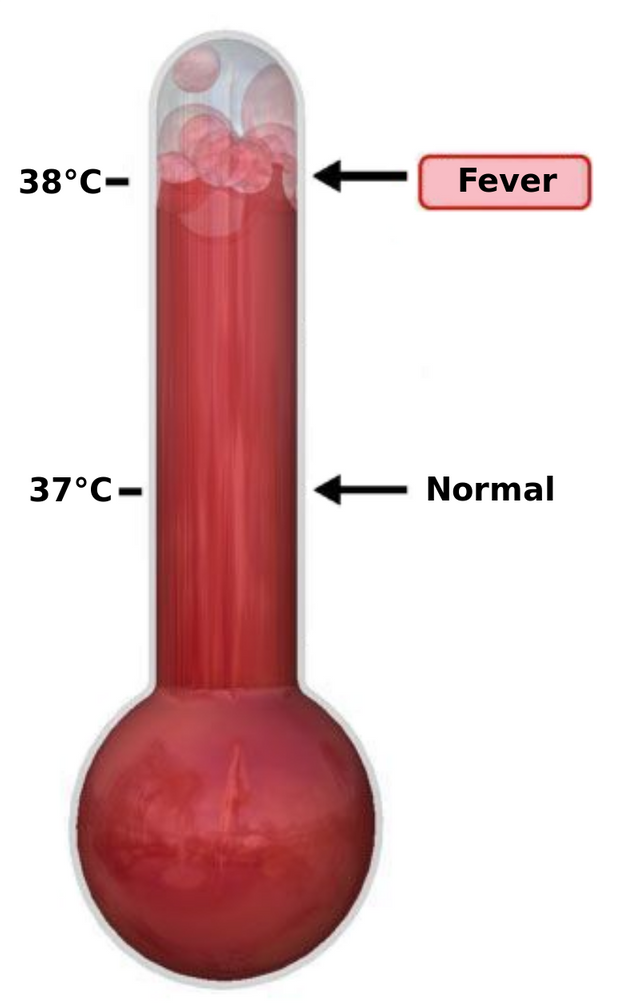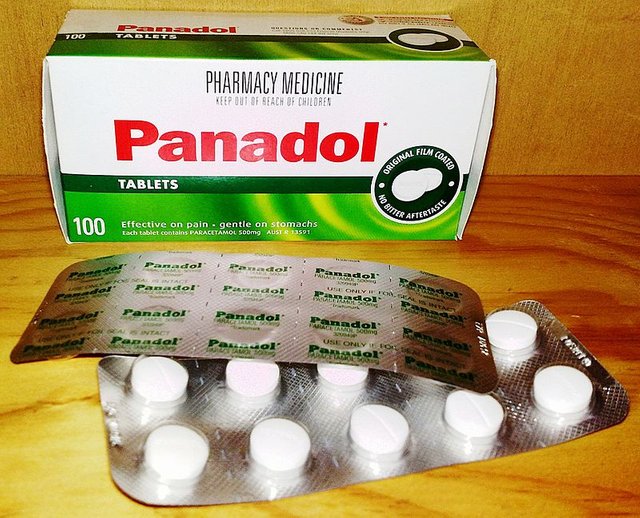How To Tell If You Have A Fever/ Steps To Go About Treating A Fever
Fever is one common medical sign that presents when suffering from a health condition, meaning that various health conditions has fever as a sign.
It is also known as PYREXIA or HYPERTHERMIA.
Fever apparently is justified as the bodies own disease fighting arsenal and helps kill certain organisms that produce disease and infections.
This post would keep us informed on the following:
Ways to easily diagnose a fever from the symptoms associated with it.
The medical instrument used to check an abnormal body temperature
The range of body temperatures that can easily be treated at home
Those body temperatures that requires medical attention
medications used to treat moderate fevers, etc.
How do you tell when you've a fever?

[Source: Wikimedia commons. Author: CDC • Public domain licensed]
The normal body temperature in degree celsius is 37°C (98.6°F) which is but an average number and a fever is mostly significant when it is above 38°C (100.4°F).
The normal body temperature happens to be an average number as I said above why because a number of factors ( our age, sex, period of the day, ones level of activity, etc) influences the human body temperature.
As it is with the elderly ones, they would have a body temperature that is usually lower than normal because at an old age, the body system would find it difficult to conserve heat.
The elderly ones from the age of 65 and above would have average body temperatures of less than or equal to 36.2°C.
While those tender in age (the infants and children) would have an average body temperature of about 36.6°C-37.2°C.
We adults would have an average body temperature of about 36.1°C-37.2°C.
From this values we can observe that it is true that older individuals have the lowest average body temperature, the adults/ children have a body that possesses the ability to regulate their body temperatures and this is one of the reason for this difference.
You've a fever when your body temperature is higher than the normal body temperature when read from a thermometer.

[Source: Wikimedia commons Author: NoPetrol (modification par The RedBurn) • CC-BY-SA-3.0. licensed]
Our body temperature can easily be checked using a clinical device known as a 'Thermometer ' and when this is placed in certain parts of our body our temperatures can be read.
The regions I'm referring to includes:
- Under The Armpit
- In The Mouth
- In The Rectum
- Behind The Ear
All this regions have different readings that detects when you've a fever.
Aside this information about using a thermometer to check your body temperature you can know you've a fever from the signs/symptoms your body presents.
Some of which includes;
- Your body getting hot
- Sweating profusely
- Having Chills/ Body Shivering
- Feeling a Headache
- General body weakness
- Feeling thirsty and dehydrated
- Loss of appetite, etc.
These are indeed the signs of hyperthermia also have it in mind that one can as well suffer from a low body temperature whereby the body temperature is lower than the normal body temperature in this case it is called hypothermia.
Some fevers could come with some more serious symptoms and this can help us know certain disease condition's that is thus causing the fever.
For example some fevers are associated with a stiffened neck, hallucinations, swelling in the throat, very high body temperature throughout the day, etc.
At this point it is wise to note that such fevers can't be treated at home, visiting the hospital for the attention of a medical professional would help him or her make proper diagnosis on the underlying health condition causing this fever and proper treatment carried out to ensure the body system stabilizes.
Besides checking the body temperature with a thermometer what other means can one identify if he or she has a fever?
We've our hands covered with skin (one of the largest organs in the human body, serving functions such as heat regulation, sensation, etc)
You can easily check if you've a fever by feeling your skin supposing you're the one suffering from a feverish condition.
You can as well use this same method to check another individuals body temperature you suspect has a fever for proper action to be taken to aid the relief of such a condition.
When using this technique, it is always better for someone else to check your body temperature for you reasons because if another person helps check your temperature it becomes easier for that individual to use his or her body temperature (this individual would have a normal body temperature and skin won't be hot like the person suspected to have a fever) as a measure to compare with your temperature.
Another way to find out or identify if you've a fever is by looking out for certain signs accompanied with dehydration.
Someone suffering from a fever easily gets dehydrated.
Imagine a pot filled up to the brim with water and covered with or without a lid on a stove with enough kerosene, when the stove is lit on the water gradually boils as the temperature increases.
If this pot remains on the stove and continues to heat evaporation begins, the liquid changes states and enters a gaseous state if left further to continue boiling.
If the pot isn't brought down from the source of heat (the stove) the pot would get empty(dried up) of it's liquid content meaning that all the water gets evaporated into the air.
If the human system isn't replenished when in a state of dehydration this wouldn't be nice at all there ought to be a balance (homeostasis).
Dehydration comes with it's own signs which includes the following:
- The patients feeling thirsty
- Constipation sets in
- The skin becomes dry
- The patient has a dry mouth, etc.
You can as well find time to check if such a patient suffers from muscle aches and stiffness this especially is a pointer to meningitis

[Patient with menigitiis and menigism (neck stiffness) Source: Wikimedia commons Author: L.A. Marty, M.D, Kansas City • Public domainlicensed]
The itis shows that there is an inflammation of the meninges, the meninges consist of about three membranes that actually covers the brain and spinal cord, meningitis is characterized by it's own symptoms there are about a number of them but frequent symptoms includes: neck stiffness, fever, chills, headache, vomiting, photophobia (sensitive to light), myalgia (muscular pains and tenderness).
What action do you take when you have successfully identified a fever that can be treated at home?
It is important to handle symptoms like those associated with fever using the right measures.
Fevers can be treated using a class of drugs known as NSAIDs ( NonSteroidal Anti-Inflammatory Drug).
A medication like Paracetamol belonging to this class acts on the hypothalamus to produce an action known as antipyresis.
Paracetamol possess both analgesic and antipyretic activities inhibiting the synthesis of prostaglandin.
Some NSAIDs likewise possess and additional activity which is been used as antiinflammatory agents...
Paracetamol comes in dosage forms like tablets, caplets (extended release), capsule, gelcap/geltab, oral disintegrating tablets, oral solution/suspension, liquid oral, etc.
Paracetamol tablet is administered at a usual dose of 500mg 6-8hourly and has a maximum dose of 4g given in 4 divided doses.
Patients are warned against using paracetamol for longer dosing intervals especially those who suffer from renal impairment and hepatic impairment.
Analgesics like Ibuprofen can likewise be used and has a usual dose of 200-400mg 8hourly, this medication has a maximum dose of 1200mg in three doses.

[Panadol Source: Wikimedia commons Author: Editor182 (talk) • Public domain licensed]
Patients suffering from a fever are advised to consume enough quantity of clear fluid to handle the case of dehydration accompanied with most fevers this is done so as to replenish the lost fluids from the body pores from excessive sweating from the hotness of the body system.
If there is soup available the patient is advised to drink soups at intervals, all this would help to improve the well being of a patient suffering from a fever.
Most Tea contains caffeine and is discouraged for patients suffering from a fever because the ingredient caffeine actually enhances dehydration making one to loose more water through urination so it is much better to take clear fluids, juices, soups and broths.
It is important to advice such a patient to have enough rest as well.
Since the patient suffering from fever would be sweating so much it is advisable not to overdress such a person, light clothes are very much better compared to thick clothes because the body can easily get cooled by evaporation or other means.
Encourage the patient to have warm baths.
Remember that if this fever can't be treated at home using this measures and the fever seems to get worse make sure you visit the hospital so a Doctor takes a proper check on you by carrying out proper physical examination, taking the medical history of such a patient, carrying out useful medical test to find out what the underlying cause of the fever.
A chest radiography (X-ray), a complete blood count/ electrolytes, urinalysis, lumbar puncture can be carried out based on the symptoms the patient is presenting.
In some cases the Doctor can prescribe antibiotics alongside NSAIDs because he could suspect that the underlying cause of such a fever is a bacterial infection and hence an agent which can inhibit the growth of organisms like bacteria is prescribed to handle such infections.

Thanks for sharing
Wow.. A lot of information packaged just in one post, damn, this is sweet to read, reminds me of school days and my industrial training at NAFDAC... drugs and their mechanism of action is one sweet area I would love to further in biochemistry... Pharmaceutical Biochemistry or advanced enzymology!
Thanks for sharing dear!
very educative article
You have a minor grammatical mistake in the following sentence:
It should be its own instead of it's own.Congratulations! This post has been upvoted from the communal account, @minnowsupport, by Eunireal1 from the Minnow Support Project. It's a witness project run by aggroed, ausbitbank, teamsteem, theprophet0, someguy123, neoxian, followbtcnews, and netuoso. The goal is to help Steemit grow by supporting Minnows. Please find us at the Peace, Abundance, and Liberty Network (PALnet) Discord Channel. It's a completely public and open space to all members of the Steemit community who voluntarily choose to be there.
If you would like to delegate to the Minnow Support Project you can do so by clicking on the following links: 50SP, 100SP, 250SP, 500SP, 1000SP, 5000SP.
Be sure to leave at least 50SP undelegated on your account.
Thanks for the info I will apply the tips that u listed there
Awesome @eunireal1 , so educative
It's good of you drawing a concrete and concise article about fever, it's a life safer as the saying goes, information is power
Excellent information in this post! This should be a readily-available source of information for everyone! Kudos!
Nice one, thanks for sharing